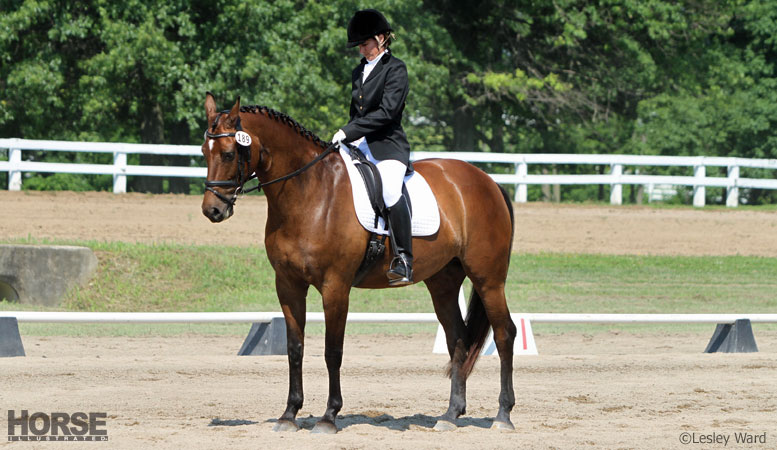How to Get a Square Halt
Q. I ride lower-level dressage and am having trouble getting my horse to halt square. Can you give some pointers? How can I feel the square halt?


A. The halt is an important skill to master because not only do you need it for the obvious reason (to dismount), but it’s a sign that your horse has good basics. A correct halt requires only soft contact, with the horse’s poll at the highest point; the halt should be square, which means the horse’s hooves should form a perfect square—with a hoof at each corner. You should also get a sense that the horse would move forward immediately when asked, rather than using the halt as an excuse to shut down. All of this shows that the horse understands the concept of moving into both reins in balance.
When your horse halts square, you’ll feel his weight evenly distributed under your seat bones. His hindquarters will seem lower, and you’ll feel his hind legs underneath your seat. It will take a while to learn to feel all these cues. Leaning down to check will probably knock your horse off balance, so ask a friend to tell you when the horse is square. You’ll soon develop a feel.
Many people incorrectly halt their horses by employing the hand brake method: pulling on the reins rather than driving the horse into a softly restrained hand. Prepare for the halt with a few half-halts, remembering to use your back, seat and legs into a closed hand. As the horse begins to halt, soften your hand. If you eliminate this final step, your horse will lean on your hand. If schooled correctly, eventually your horse will become so tuned to your aids that he will need only a little bit of seat and a soft, restraining hand to halt.
If your horse is not engaged correctly, isn’t moving equally into the contact from both hind legs, or isn’t responding to your seat and leg, he won’t halt square. An un-square halt can also be the fault of the rider using one leg more than the other.
If the horse isn’t moving into both reins, you’ll feel an uneven contact. As you practice the halt, tap with your leg (and whip if need be) on the side of the horse’s body where the rein feels heavy or empty. This will help encourage that lazy leg to step under. Also, make sure that you aren’t forcing the horse off balance by sitting crooked. Look up as you halt to keep yourself straight.
Recent Posts
2025 FEI Basel World Cup Finals Hands Reins to Fort Worth 2026
As U.S. athletes look back on valuable experience gained at the 2025 FEI World Cup Finals in Switzerland, the next…
How to Clean a Horse’s Sheath
If you’ve never cleaned a horse’s sheath, you probably have questions. First and foremost, is it really necessary? And more…
All Three Equestrian Sports Receive Final Confirmation for the LA 2028 Olympic Games
After a nail-biting two years of speculation about the inclusion of equestrian sports in the next Olympic Games, it was…
ASPCA Right Horse Adoptable Horse of the Week: Xanthus
Welcome to Horse Illustrated’s weekly installment of the Right Horse Adoptable Horse of the Week, offered in partnership with the…
Be Your Horse’s Joint Health Champion
Equine arthritis can affect horses of all disciplines and ages, and early intervention is crucial for maintaining comfort and performance.…
Tamie Smith: Taking It To The Next Level
Mother, grandmother, and winning 5* eventing rider—these three titles don’t typically go together. However, Tamie Smith, 49, is all of…
View Comments
very good info
good info
good
I really liked this, It is what I was exactly looking for. And seems she answered the questions correctly to the person who asked.